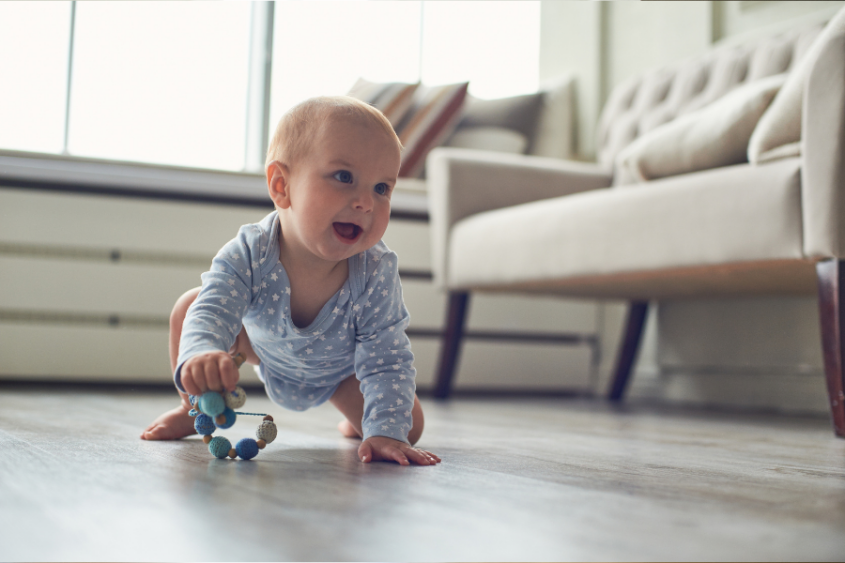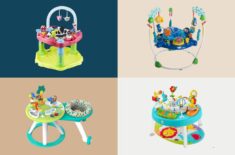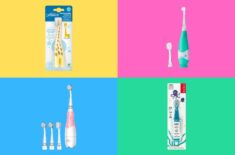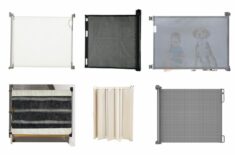Is Childproofing Necessary?
Around 2,000 children ages 0-14 die from home injuries every year. The leading causes of death are falling, choking, drowning, suffocation, poisoning, fire, burns, and firearms. (1)
Before babyproofing your entire home, remember that being OA (overreactive) is totally okay.
Think ahead and imagine everything that could go wrong. Ask yourself if your little one can climb on this, pull or push that? Could they yank, bump, choke, slip, get stuck on, or topple over something?
Babyproofing your entire home can be overwhelming, so it’s better to babyproof one room at a time.
In this article, we’ll be listing all babyproofing safety tips and tricks to break down the huge task of childproofing your home.
Also, remember that babyproofing is an ongoing process as your child grows. The door guards you put when your baby is one-year-old can be their favorite climbing structure when they turn two.
What Does Babyproofing Mean?
Babyproofing is making something safe for babies or young children by minimizing potential hazards.
When Should I Babyproof My House?
The ideal time to babyproof your house is before your baby starts crawling, usually around six months old. (2)
If your little one is already crawling and your house is not babyproofed just yet, don’t worry, mama. Babyproofing is a continuous process of adjusting safety measures as your child grows. It’s never too late to start.
What Is The Best Way To Baby Proof Your Home?
New parents can use their parenting instincts to guide them when babyproofing their home–and that is to keep away all dangerous items from their little one.
It can be overwhelming, so we made a list for you:
Install Babyproof Carpeting or Mats
A bare, hard floor may be too much for delicate knees.
Install Outlet Covers
Keep curious babies away from electric sockets by installing tight-fitting electrical outlet covers that are difficult for babies to pull out.
Secure Furniture To The Wall
To prevent tipping over and falling when your little one tries to climb on them.
Install Corner Guards
Corner and edge bumpers will buffer sharp corners and sharp edges to prevent bump injuries.
Apply Lead-Free Paint
Older homes built before 1978 are highly likely to have lead-based paint, especially on the windows and windowsills, doors and door frames, stairs, railings, and porches. (3)
Children can be in danger of lead poisoning if they touch and ingest lead from peeling paint.
Lead poisoning can harm the brain and nervous system, slow growth and development, and cause learning, behavioral, hearing, and speech problems. (4)
What You Can Do:
- Hire a professional lead inspector to check your home for lead.
- Check your home for deteriorating paint.
- Apply lead-free paint. Lead paint is usually concerning when it’s completely covered with layers of lead-free paint. (3)
Apply Stickers Or Decals On Glass Doors
Apply stickers at eye level for kids and adults to prevent everyone from bumping on glass.
Install Doorstops
To prevent fingers from injuries.
Install Safety Gates
On stairs and doorways and keep your baby safe in a designated area in the house.
Tips When Choosing A Safety Gate
- Choose baby gatesthat are difficult for your child to open but easy for you to open and close. This will prevent you from leaving the safety gate open when you’re rushing.
- Don’t use pressure-mounted baby gates since they tend to loosen over time. Choose wall-mounted gates instead.
- Find the JPMA (Juvenile Products Manufacturers Association) seal.
Vacuum Regularly
To remove dust where your baby will be crawling and suck up potential choking hazards like loose change, buttons, paper clips, etc.
Install CO & Smoke Detectors
Carbon Monoxide Detectors
Carbon monoxide is an invisible killer that’s odorless, colorless, and couldn’t be easily detected without carbon monoxide detectors. (5)
Heating, cooking equipment like gas, or charcoal grills that burn fuel or vehicles and generators are common sources of carbon monoxide at home. (5)
CO poisoning can be fatal, especially for infants. (5)
- Install carbon monoxide detectors on every level of the home in a central area outside every sleeping space. (5)
- Interconnect the CO alarms. When one goes off, all go off.
- Test CO alarms monthly, and replace them as instructed in the manual.
- If the alarm goes off, check for low batteries and replace them if needed. If the alarm continues, call the fire department from a fresh air location.
- Stay outside or by an open window or door until safety personnel arrives and tells you it’s safe to return home.
Smoke Detectors
- Have smoke detectors on all levels of the home, in every room, and outside every sleeping space. (6)
- Interconnect the smoke alarms. When one goes off, all go off.
- Test your smoke alarms every month.
- Replace batteries every year.
- Replace smoke detectors every ten years.
- When a smoke alarm goes off, get outside and stay outside.
- Call the fire department and don’t go back home unless they tell you it’s safe.
Prepare A First Aid Kit
- Buy a first aid kit or make your own.
- Have one at home and one in your car.
- Include personal medications and emergency phone numbers in your kit.
- Check your kit regularly.
- Replenish your supplies and replace any used or out-of-date contents.
Learn First Aid Response & Infant CPR
First aid responses for babies and young children are different than that for adults. Their bodies are still forming, therefore more delicate, and require extra care.
To ensure your baby’s safety, consider taking first aid lessons and infant CPR training.
When To Call 911
- When your home safety alarms go off.
- When an emergency arises.
How Do You Babyproof A Living Room?
- Cover furniture corners like coffee tables, chairs, and cabinets with corner guards.
- Stash electrical and window cords.
- Choose cordless window coverings.
- Place floor lamps behind other furniture to prevent your little one from pulling it over.
- Install window guards and bars with a quick-release feature in case of emergency.
- Lock guns away unloaded, bullets locked away separately.
Pediatricians from the AAP (American Academy of Pediatrics) believe that the safest way to ensure your baby’s safety from guns is to have no guns at home. (7)
How Do You Baby Proof A Kitchen?
- Keep the door closed or install a baby safety gate on the entryway.
- Put stove knob covers.
- Lock knives and appliances away.
- Unplug appliances, hide cords, and cover outlets.
- Avoid using tablecloths and placemats–babies can yank these and everything on top.
- Clear the counter and tabletops–don’t keep hot dishes and liquids lying around.
- Keep alcoholic drinks away.
- Keep matches and lighters away.
- Install cabinet, dresser, and drawer locks, so they don’t become ladders.
- Install spring-loaded hinges on any storage chests to prevent the lid from slamming shut.
- Storage chests should have air holes in case your child gets trapped inside.
- Switch to safer cleaning products like nonchlorine bleach, apple cider vinegar, baking soda, etc.
- Keep cleaning supplies locked.
- Keep plastic bags away to avoid suffocation.
- Keep the aluminum foil box away–the sharp cutting edges are dangerous.
- Store glassware up high or in a locked cabinet.
- Avoid using the front burners on the stove. If unavoidable, turn the pot handles toward the back to keep it away from curious hands.
- Install a stove guard.
- Keep the lid on the sink, especially if yours has disposal.
- Install an anti-scalding device on the faucet or set your water heater to 120°F, the maximum safe hot water temperature.
- Use a stable high chair with a wide base and safety strap. If using a hook-on chair, clamp it securely to a table that won’t tip over.
- Use a mug with a lid when drinking hot beverages around your child.
- Consider leaving a “safe drawer” for your child to explore. Fill it with non-sharp and nonbreakable things.
How Do You Babyproof An Oven?
- Install door locks and safety latches on the oven and refrigerator.
How Do You Babyproof A Bathroom?
- Keep the bathroom door closed.
- Install a toilet lock.
- Install cabinet locks.
- Hide medications and keep them in their original container to avoid dangerous mix-ups.
- Hide sharp utensils like razors, scissors, and nail clippers.
- Put rubber or silicone covers on the tub spout and bathtub knobs.
- Put a nonslip rubber mat on the floor.
- Hide the garbage can.
- Install an anti-scalding device on the tub faucet or set your water heater to 120°F (49°F), the maximum safe hot water temperature. (8)
- Unplug all electrical devices and appliances after use.
- Install a GFCI (ground-fault circuit interrupter) on all electrical outlets.
How Do You Babyproof A Nursery?
- Install doorknob covers.
- Mount cabinets and dressers to the wall with child-proof locks.
- Choose an open toy box to prevent climbing.
- Choose child-safe window blinds.
- Install window guards and bars with a quick-release feature in case of emergency.
Baby’s Crib
- When buying your baby’s crib, look for the JPMA (Juvenile Products Manufacturing Association) label.
- Check the CPSC’s (U.S. Consumer Product Safety Commission) website for the list of recalled baby cribs.
- Keep the crib bare and arranged on the lowest setting now that your baby is starting to pull up.
- Crib slats should be spaced evenly and closely to not fit a soda can in between.
- Mattress should be firm and snug. You shouldn’t be able to fit two adult fingers between the crib and the mattress.
- Rail height should be 26 inches from the lowest level.
- Wood cribs shouldn’t have any splinters, and the paint shouldn’t be peeling.
- Remove hanging toys to avoid strangulation.
- Keep the crib away from the window, heaters, lamps, decorations, cords, and furniture your baby could climb on.
- Drop-side cribs have been banned by the CPSC. (9)
Safely Transitioning From Crib To Bed
- If your child can already climb across the crib railing, it’s not safe for them to sleep there.
- Place a mattress on the floor instead. Put pillows as guards since your child is used to sleeping in an enclosed space.
- When they transition to a toddler bed, put up railings.
Changing Table
- Secure the changing pad to the changing table.
- Use a safety strap.
- Always keep one hand on your baby.
- Put a thick piece of carpet or a rug to cushion falls.
How Do You Babyproof A Home Office?
- Keep the door locked.
- Hide electrical cords.
- Hide choking hazards like paper clips, tiny buttons, coin lithium batteries, staples, thumbtacks, and push pins.
- Cover electrical outlets.
How Do You Babyproof A Laundry Room?
- Set or install child locks for front-loading washers and dryers.
- Choose child-proof garbage cans, or hide them in locked cabinets.
- Lock away all cleaning materials and laundry solutions.
- Avoid colorful liquid laundry gel packets–these can be tempting for children to eat.
- Call poison control if you suspect poisoning.
How Do You Baby Proof A Fireplace?
- Install a fireplace screen, and keep the keys out of reach.
- Store logs, matches or lighters, and all fireplace tools away.
- Don’t leave an open fire unattended.
Babyproofing Outdoor Living Spaces
How To Babyproof The Deck
- Install child safety railings spaced no wider than four inches.
- Double the protection by installing garden fencing between the railings and securing it with plastic cord ties. Don’t use staples as these can be dislodged and pose a choking hazard.
- Keep patio furniture away from the railings.
- Secure external stairs by installing safety gates.
How To Babyproof The Patio
- Choose childproof patio furniture with no sharp edges or bulging nails and screws.
- Cover fire pit tables and grills.
- Keep matches and lighters away from curious hands.
How To Babyproof The Yard
- Install fencing around your garden.
- Keep toxic plants away from your baby’s reach.
- Keep gardening tools and solutions in a locked cabinet or shed.
- Secure playground guardrails.
- Trim tree branches around the play area.
- Place rubber mats under the play area or treehouse to cushion falls.
- If you have a treehouse, it’s best to build it close to the ground.
How To Babyproof The Pool
- Put up a fence all around the pool. The fence should be at least four feet tall.
- Install a self-closing pool safety gate.
- Install an entry alarm on the pool safety gate or install a power safety cover on the pool.
- Keep the hot tub covered, security buckles fastened.
Tips To Reinforce Safety Lessons
Reinforcing safety lessons for your child is also a part of effective babyproofing. It’s also good practice to instill discipline in your baby in their first year of life.
Establish boundaries.
You can use simple words and actions to let your child know what they can and can’t touch.
Use warning words.
Words like “no,” “ouch!” or “hot” are easy for your little crawler to understand.
Use positive reinforcement.
Instead of completely prohibiting them from touching or doing anything, offer them an alternative: “Don’t touch that; play with this instead.”
Other Potential Hazards
Purses
Don’t keep purses lying around as these may contain choking hazards like coins or buttons, medications, toiletries, etc.
Balloons
Uninflated or burst pieces of balloons are choking hazards.
Bucket of water
Young children are top-heavy and can easily drown in a few inches of water.
Toxic house plants
Place toxic house plants in inaccessible places for your baby, or move them outdoors.
Pet food
Clean up after your pet to make sure no pet food is left on the floor your baby could eat.
Water bottle caps
Water bottle caps are potential choking hazards.
When To Call A Childproofing Consultant
If you’re still unsure about babyproofing and would like more guidance, you can call a childproofing consultant and discuss your concerns. These consultants tend to have a higher price tag, so make sure they fit your budget before committing to services.
12 Tips When Buying Childproofing Products
Follow these suggestions from the Consumer Product Safety Commission (CPSC):
1. Choose locks and safety latches that are easy for adults to use but difficult for children to pull, tug, or dislodge.
2. Choose child safety gates that are easy for adults to open and close but difficult for children to do so.
- The safest option is wall-mounted safety gates for the top and bottom of the stairs. (10)
- Choose baby gates that meet the current safety standards.
- Avoid safety gates with V-shaped gaps that are large enough to trap and strangle children. (10)
3. Choose door knob covers that are sturdy yet easy for adults to open in an emergency.
4. Choose window guards with a quick-release feature and limit window openings to four inches or less. Window screens are not effective in preventing falling out of windows. (10)
5. Choose cordless window blinds and coverings.
6. Choose corner guards and edge bumpers that securely hold.
7. Choose snug-fitting electrical outlet protectors that are large enough not to be a choking hazard. When replacing receptacles, a tamper-resistant type is ideal. (10)
8. Equip free-standing stoves and ranges with anti-tip brackets.
9. Choose heavy-duty wall-mounting brackets for your furniture and appliances.
10. Choose an automatic mixing anti-scald device to prevent scalding. These are single-handle, pressure-balanced devices that blend both water temperature and pressure. (11)
11. Choose smoke alarms with a reliable battery backup in case of power failure.
12. Choose carbon monoxide detectors that meet the safety requirements and feature a reliable battery backup.
Important: Regularly check these safety devices to ensure they are properly installed and maintained.
Toy Safety Guidelines
- Choose toys according to your child’s age and development.
- Choose toys made of natural materials.
- Choose unpainted wooden toys.
- Choose washable fabric toys.
- Choose toys with clear safety labels: BPA, phthalate, and PVC-free.
- Choose nontoxic art materials.
- Avoid toys with metal parts for babies.
- Avoid toys with small parts like eyes, noses, etc., that could come off.
- Avoid loud toys. Those can damage your baby’s hearing.
- Avoid toys with strings longer than seven inches.
- Avoid flying toys.
- Avoid toys that shoot out objects like a toy dart gun.
- Avoid electric and battery-operated toys.
- Avoid toys with magnets.
Important: Separate toys by age. Toys intended for older children may be dangerous to younger ones.
- Keep toys off the floor when not in use.
- Keep toys in a box or basket with no lid.
- Keep an eye on damages. Sand splinters if needed. Use new paint when repainting–old paint may contain lead. Check outdoor toys for rust. Throw it away if it can’t be repaired. Check magnetic toys for any loose magnets.
- Keep plastic packaging away.
- Keep the toy instructions.
- Check CPSC’s website for recalled toys.
How To Babyproof Away From Home
- Choose a car seat fit for your child’s age.
- Check the car seat’s height and weight limit.
- The best baby car seat should be snug once installed.
- When installed rear-facing, the car seat harness should be at or below your baby’s shoulders. (12)
- Check the child-safety features of your car.
- Check for hazards: choking, suffocation, drowning, burning, scalding.
- Remove breakable items or jagged pieces.
- Remove tablecloths and placemats.
- Check that cleaning supplies, bath essentials, medications, and all sharp utensils are hidden.
- Check for plants. If you can’t identify if they’re toxic or not, it’s best to keep them away from your child’s reach.
- Supervise your child at all times.
REFERENCES
:(1) https://www.stanfordchildrens.org/en/topic/default?id=accident-statistics-90-P02853
(2) https://helpmegrowmn.org/HMG/HelpfulRes/Articles/BabyMilestones/index.html
(3) https://www.epa.gov/lead/protect-your-family-sources-lead
(4) https://www.cdc.gov/nceh/features/leadpoisoning/index.html
(5) https://www.nfpa.org/Public-Education/Staying-safe/Safety-equipment/Carbon-monoxide
(6) https://www.nfpa.org/Public-Education/Staying-safe/Safety-equipment/Smoke-alarms
(7) https://publications.aap.org/aapnews/news/14853
(8) https://www.cdc.gov/healthywater/drinking/preventing-waterborne-germs-at-home.html
(9) https://www.cpsc.gov/Newsroom/News-Releases/2010/CPSC-Issues-Warning-on-Drop-Side-Cribs32-Fatalities-in-Drop-Side-Cribs-in-Last-9-Years
(10) https://www.cpsc.gov/safety-education/safety-guides/kids-and-babies/childproofing-your-home-12-safety-devices-protect
(11) https://www.asse-plumbing.org/media/5216/asse_guidelines_for_temp_control_devices.pdf
(12) https://www.consumerreports.org/cro/car-seats/buying-guide/index.htm












